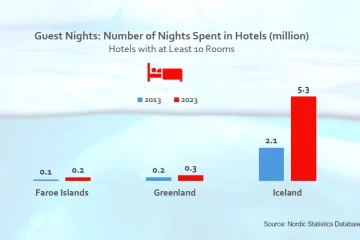Having lived in Greenland and worked at Statistics Greenland, I (Ulla Agerskov) have always found the data collected in their publications to be incredibly insightful and important. The just released “Greenland in Figures 2024” provides a comprehensive overview of this fascinating land. Below, I delve into key statistics and their sociological implications, highlighting significant aspects of Greenland’s population, health, economy, climate, and more.
💡Hint: Unlock more insights by clicking on the tables below.
Demographics and Population Dynamics
- Population Density: With an overall density of 0.03 persons per square kilometer, Greenland is one of the least densely populated areas globally. When considering only the ice-free zones, this density increases to 0.3 persons per square kilometer, emphasizing the vast stretches of uninhabitable terrain.
- Population Distribution: The population is unevenly distributed among Greenland’s municipalities. Kommuneqarfik Sermersooq, including Nuuk, is the most populated with 23,000 residents, while Avannaata Kommunia has about 10,000 residents.
- Population Overview: As of January 2024, Greenland’s population stands at 56,699, dispersed across its vast expanse. Nuuk, the capital, houses 19,872 people, highlighting a significant urban concentration in an otherwise sparsely populated region.

Health and Longevity
- Life Expectancy: The life expectancy in Greenland is 69.7 years for men and 73.4 years for women, lower than the Western average, primarily due to higher rates of accidents and suicides.
- Birth and Death Rates: Annually, there are approximately 700 births and 500 deaths. The high birth rate contrasts with the aging population, indicating a complex demographic transition.
- Health Challenges: Persistent health challenges include higher rates of tuberculosis and sexually transmitted infections. Lifestyle-related diseases, such as cardiovascular conditions and cancers, significantly impact mortality rates. The suicide rate remains notably higher than in other Nordic countries.

Education
- Educational Attainment: Over half of the population aged 25-64 has no education beyond primary school. Only 13% have completed higher education, highlighting ongoing educational challenges.
- Higher Education: About 30% of Greenlandic students pursue higher education abroad, mainly in Denmark, due to limited domestic offerings. The University of Greenland in Nuuk is the primary institution for higher education.

Employment and Income
- Unemployment Rates: The unemployment rate varies seasonally and geographically, with an average of 3.2% in 2022. Most unemployed individuals have only primary education, underscoring the need for improved vocational training.
- Income Distribution: Average income levels vary significantly, with the highest in Nuuk and the lowest in smaller settlements. The median annual income is around 300,000 DKK.
- Employment Structure: The public sector employs over 40% of the workforce, reflecting the significant role of government services in the Greenlandic economy. Conversely, the fishing industry, crucial for export revenues, employs about 15% of the workforce.

Economic Structure
- Fishing Industry: Fishing is a cornerstone of Greenland’s economy, accounting for a substantial portion of exports and employment. In 2023, Greenland’s fishing fleet consisted of 288 vessels, with major catches including shrimp (54,500 tonnes) and halibut (33,400 tonnes). The industry is dominated by Royal Greenland and Polar Seafood.
- Tourism: Tourism in Greenland has experienced notable growth in recent years. Comparing recent data to figures from 2015, there has been a significant increase in visitors, especially from Nordic countries.

Hunting
- Hunting Licenses: In 2022, approximately 7,000 hunting licenses were issued in Greenland, divided between professional and sports hunters. This system ensures sustainable hunting practices and regulates the number of animals available for hunting.
- Seal Hunting: In 2022, hunters caught 59,922 seals, a significant number reflecting the practice’s importance for local communities.
- Other Wildlife: Various whale species are hunted under strict quotas, with 4,709 whales caught in 2022. Reindeer and musk oxen are the primary land mammals hunted, with 12,399 land mammals harvested that same year. Bird hunting, although less regulated, also plays a role in the local diet and culture.

Environmental and Climate Conditions
- Climate Variability: Greenland’s climate ranges from high Arctic in the north to sub-Arctic in the southern fjords. The highest recorded temperature was 25.9°C, while the coldest was -69.6°C on the ice cap.
- Renewable Energy: Five hydroelectric plants significantly contribute to the energy supply, producing 1,639 terajoules in 2022. However, smaller communities still rely heavily on fossil fuels.

“Greenland in Figures 2024” provides essential insights into the sociological landscape of Greenland. The demographic shifts, health challenges, and educational needs highlight the dynamic nature of Greenlandic society. As Greenland navigates modern development while preserving its unique cultural heritage, these statistics offer a valuable perspective on the lived experiences of its people.
Dig into the publication yourselves and find many more facts and figures! 📊📖🐋❄️🌊🦭🏔️

Our forthcoming, “Nordic Insights”, will delve further into aspects on sustainable development, providing more of the data we cherish so much.
👀❄️ Stay tuned!




0 Comments